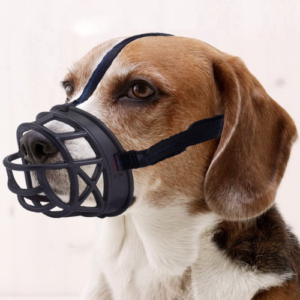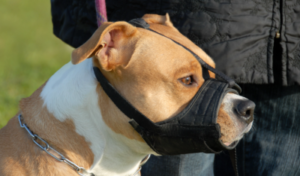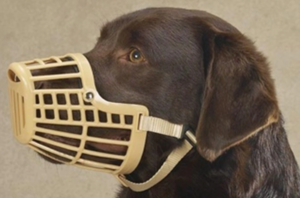 Benefits of Dog Muzzles and Muzzle Training
Benefits of Dog Muzzles and Muzzle Training
Training your dog to put on a muzzle during walks will help prevent him from eating things that might not be safe for his digestive system.
Another good reason for you to start muzzle training your dog is that you know that he doesn’t know how to socialize with people or with other dogs.
As a dog owner, you might have encountered your dog trying to eat the vet staff alive as they trim his nails or draw some blood from him.
Such an encounter can be quite embarrassing and dog muzzles can be a remedy. Muzzle training your dog to put on a muzzle will save you from such embarrassing situations while still making things like vet procedures less scary for your dog.
What are The Benefits of Dog Muzzles?
Dog muzzles are like seat belts for dogs. They are useful in many different ways which include:
-
Muzzles Help Prevent Injuries
Your dog being vicious is not the only reason why you should get him a muzzle. Your veterinary doctor may insist on getting your dog a muzzle to prevent injuries to other people or dogs.
It is not because your vet considers your dog violent, it is mostly because vet visits are often stressful to our dogs. After all, some of the procedures can be painful. When your dog is in pain, he might react by trying to bite the source of pain, but with a muzzle on, he won’t.
-
Grooming Purposes
Another reason to consider dog muzzles and muzzle training for your favorite canine friend is effective grooming reasons. All pets, especially dogs, are quite protective over their feet and many of them will not just sit down and have their nails clipped. Using a muzzle will put the mind of a groomer at ease, by ensuring that he/she won’t get attacked by the dog.
Read: Best Dog Shedding Brushes
-
Muzzles Help Contain Violent Dogs
If there is a high risk of your four-legged friend biting other pets or people, it is important that keep him muzzled. By doing so, you not only protect other animals and people from getting hurt, but you also save your dog from getting into trouble.
If you have a violent dog and he attacks other pets or people, you can find yourself in serious legal trouble. By teaching your vicious dog to put on a muzzle, you enable him to socialize with other pets in a friendly manner.
-
Important During Recovery
When your canine friend is recovering from any medical procedure or injury, it is a common practice to put a cone or muzzle around his face. You do so to prevent him from licking and biting his wounds.
If he is stitched up, the stitches can become so itchy for him and he will want to take out the stitches using his mouth. If you use a muzzle, however uncomfortable the wounds and stitches are unreachable to the dog, in doing so you will be helping him recover from his wounds faster.
-
Helps Prevent Food Poisoning
Do you have a dog who eats everything and anything he comes across when you are out on a walk? Training your dog to wear a basket muzzle during walks will help prevent him from ingesting harmful substances.
Take the worry away from your professional dog walker by teaching them how to apply the muzzle for safe walks while you are away. If you are a first dog owner or a dog owner who wants to muzzle train his/her dog for the first time, here is the procedure on how to go about it.
How to Teach a Dog to Wear a Muzzle
Teaching a pooch how to wear dog muzzles isn’t that tough. However, you need to practice consistency and be very patient with your canine friend. For best results, work to make your pup associate wearing the muzzle with positive things such as affection or rewards. Today, we are going to use positive reinforcement through the treatment method. You will require:
- A bag of treats that your dog loves.
- A muzzle
- A clicker (not a must)
Step 1: Make your dog associate the sound of the clicker with getting a treat. You can do this by putting the treat on your hand while engaging yourself in a different activity such as reading or using the phone.
In most cases, your dog will get excited by the treat, but give it to them once they have calmed down. As soon as the dog starts to behave nicely, use the clicker and then give him the treat. Do this several times until they start to positively react to the sound of the clicker and looking around for their treat.
Step 2: While still holding the clicker and a treat, slowly introduce the muzzle and get your dog to try to sniff it. As soon as they do so, click and reward him with the treat. Repeat the procedure over and over again until the dog eventually learns to put its nose in the muzzle.
With time your dog will eventually learn how to keep his nose in the muzzle for a longer period. After your dog knows how to put on the muzzle on his own, move the straps around as if you are going to strap the muzzle on. Once you successfully get the muzzle on completely, take it off and give your dog another treat.
Step 3: Increase wearing time. Once your dog can successfully put on the muzzle on his own, train him to wear it for longer periods. As soon as he can snuggly wear the muzzle for a few minutes at a time, head outside with him still wearing the muzzle and there will lot of things to keep him distracted to a point he even forgets that he is wearing something on the mouth.
Remember: if you use a tube-style muzzle that restricts your dog’s ability to pant, only have your dog wear it for a few minutes at a time. If you are going to engage your dog in strenuous exercise, use a basket-style muzzle that allows them to pant. Lastly, always make sure that your dog wears a muzzle if only he is being supervised. Never leave a muzzle on an unsupervised dog.
Watch: Basket Muzzle Training
Types of Dog Muzzles
Dog muzzles are available in two basic types: slip muzzles and basket muzzles.
1.Slip Muzzles
 These are types of dog muzzles that you will commonly see at a veterinary clinic. They are commonly made of solid or mesh fabric with an opening at the end. In most cases, these muzzles have a quick-release strap for the neck strap.
These are types of dog muzzles that you will commonly see at a veterinary clinic. They are commonly made of solid or mesh fabric with an opening at the end. In most cases, these muzzles have a quick-release strap for the neck strap.
Advantages of Slip Muzzles
- They slip on the dog’s mouth quickly and are quick to fasten.
- Easier to fit on dogs with smaller noses.
- Soft and comfortable for dogs.
- Depending on the fit, some dogs may be able to take small treats while the muzzle is still on.
- Easy to clean by hand or by use of a machine.
Disadvantages of Slip Muzzles
- When properly fit, slip muzzles are snug around the muzzle. As a result, dogs wearing the muzzle might have a problem panting well to cool off.
- If the slip muzzle is so tight that the dog can’t open his mouth to pant, the same dog will have problems opening his mouth to bite food or any treats.
2.Basket Muzzles
 Basket muzzles are the most common dog muzzles. These muzzles are stiff and cover the entire dog’s mouth. They are made of hard or soft plastic, coated wire, or leather. They are relatively solid and more open compared with the slip muzzles.
Basket muzzles are the most common dog muzzles. These muzzles are stiff and cover the entire dog’s mouth. They are made of hard or soft plastic, coated wire, or leather. They are relatively solid and more open compared with the slip muzzles.
Advantages
- These dog muzzles cover the entire dog’s muzzle and mouth.
- Basket muzzles are often loose around the dog’s nose, allowing them to easily open their mouth.
- Your dog gets to pant, eat and drink while still wearing a basket muzzle.
- Dog muzzles made of either plastic or wire are usually easy to open.
- Better for longer-term usage.
Disadvantages
- Takes more time to put on a basket muzzle than a snip muzzle.
- Leather basket muzzles are difficult to clean.
- It is hard to find a basket muzzle that will snugly fit a short-nosed dog.
Related Post: Best Dog Treat Bags
Frequently Asked Questions About Dog Muzzles
Q: Are Muzzles Good for Dogs?
A: If used properly, a dog muzzle is an excellent item for your dog. Your dog will be just fine if he is wearing his muzzle properly. Make sure that the muzzle is neither too tight nor too loose.
The best fit is one that enables your dog to pant, eat and drink while still wearing the muzzle. Make sure that you only use the muzzle when it’s necessary and doesn’t leave it on your dog for long periods.
Q: Why Do Dogs Wear Muzzles?
A: Most dogs need to wear muzzles not because they have ever bitten anybody, but because it is safer to have your dog wear his muzzle when you have an appointment with the vet or when you are out for a walk. Some dogs wear muzzles because they need space and when people see a dog with a muzzle on, they will give him a wide berth.
Conclusion
Dog muzzles are some of the most misunderstood but most essential tools in dog training. Dog muzzles will provide you with a way to keep other pets and people safe from your dog. That doesn’t mean that all dogs with muzzle are bad dogs. When you get your dog to put on a muzzle, make sure that he doesn’t wear it for so long as it can become quite uncomfortable for him.
